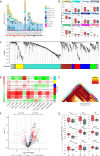Tertiary lymphoid structures in Merkel cell carcinoma facilitate naïve and central memory T-cell infiltration linked to immunotherapy response
- PMID: 40992783
- PMCID: PMC12458699
- DOI: 10.1136/jitc-2025-012224
Tertiary lymphoid structures in Merkel cell carcinoma facilitate naïve and central memory T-cell infiltration linked to immunotherapy response
Abstract
Background: The presence of tertiary lymphoid structures (TLS) in solid tumors, including Merkel cell carcinoma (MCC), is associated with a better prognosis and a better response to immunotherapy with immune checkpoint inhibition (ICI). The detailed mechanisms by which TLS influence antitumor immune responses are only partially understood.
Methods: Clinically annotated tumor tissues of 27 patients with MCC were obtained prior to ICI therapy. Tumor samples were subjected to transcriptomic and multiplex immuno-visual profiling, T-cell receptor (TCR) clonotype mapping, as well as-in selected cases-spatial transcriptomics to comprehensively characterize the tumor immune microenvironment.
Results: Weighted gene co-expression network analysis (WGCNA) of transcriptomic data in combination with topological overlap measures indicated a higher abundance of TLS in tumors of patients with MCC responding to ICI therapy. This concept was substantiated through immunomorphological analyses, revealing mature B-cell follicle-like structures characterized by high endothelial venules (HEVs). Further supporting HEVs as critical entry points for naïve T cells, the presence of TLS was correlated with a pronounced infiltration of CD4+ and CD8+ T cells, exhibiting both naïve and central memory phenotypes. The TCR repertoire of these infiltrates exhibited enhanced richness and diversity with a pronounced reactivity toward Merkel cell polyomavirus-derived T-cell epitopes. Spatially resolved RNA and V(D)J sequencing revealed the expression of genes associated with T-cell recruitment within TLS, alongside the presence of naïve and central memory T-cell markers. Notably, individual clonally expanded TCR transcripts were detected both within TLS and among tumor-infiltrating lymphocytes. The latter were associated with low expression of memory cell markers and high expression of effector cell markers. Additionally, a spatial gradient in the expression of genes linked to immune stress in MCC cells-such as those involved in the interferon-γ response and antigen processing and presentation machinery-originated in proximity to the TLS.
Conclusion: Our findings are consistent with a key role of TLS in shaping immune interactions within the MCC microenvironment, driving the recruitment of diverse tumor-reactive T cells. These insights hold promise for advancing immunotherapeutic strategies.
Keywords: T cell receptor - TCR; Tumor microenvironment - TME; biomarker; immune checkpoint inhibitor; skin cancer.
© Author(s) (or their employer(s)) 2025. Re-use permitted under CC BY-NC. No commercial re-use. See rights and permissions. Published by BMJ Group.
Conflict of interest statement
Competing interests: JCB is receiving speaker’s bureau honoraria from Amgen, MerckSerono, Pfizer, Sanofi, and Sun Pharma and is a paid consultant/advisory board member/DSMB member for Almirall, Boehringer Ingelheim, ICON, Pfizer, and Sanofi/Regeneron. JCB’s group receives research grants from Merck Serono/IQVIA, Regeneron, and Alcedis. SU declares research support from Bristol Myers Squibb and Merck Serono; speakers and advisory board honoraria from Bristol Myers Squibb, Merck Sharp & Dohme, Merck Serono, and Novartis; and meeting and travel support from Almirall, Bristol Myers Squibb, IGEA Clinical Biophysics, Merck Sharp & Dohme, Novartis, Pierre Fabre, and Sun Pharma; outside the submitted work. EL received honoraria from Novartis, Medac, Bristol Myers Squibb, Regeneron, Sanofi, Sun Pharma, and Pierre Fabre, reports consulting/advisory roles with Bristol Myers Squibb, Pierre Fabre, and Novartis; and received travel/accommodations/expenses from Pierre Fabre and Sun Pharma. PM received payment or honoraria for lectures, presentations, speakers’ bureaus, manuscript writing, or educational events from MSD, Novartis, BMS, Pierre Fabre, Sanofi Genzyme, Immunocore, Regeneron, Delcath, and Sun Pharma. Participation on Data Safety Monitoring Board or Advisory Board: MSD, Novartis, BMS, Pierre Fabre, Sanofi Genzyme, Immunocore, Regeneron, Delcath, Sun Pharma, Biotech. Support for attending meetings and/or travel: MSD, BMS, Sun Pharma, Novartis. CE does scientific consulting for 10x Genomics.
Figures



References
MeSH terms
LinkOut - more resources
Full Text Sources
Medical
Research Materials
